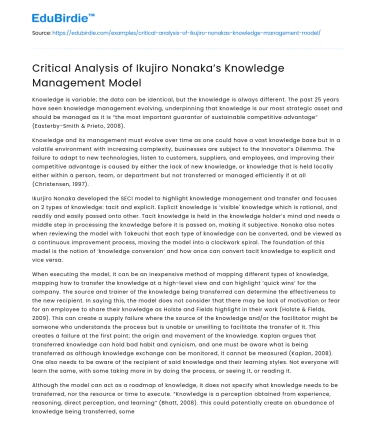Knowledge is variable; the data can be identical, but the knowledge is always different. The past 25 years have seen knowledge management evolving, underpinning that knowledge is our most strategic asset and should be managed as it is “the most important guarantor of sustainable competitive advantage” (Easterby-Smith & Prieto, 2008).
Knowledge and its management must evolve over time as one could have a vast knowledge base but in a volatile environment with increasing complexity, businesses are subject to the Innovator’s Dilemma. The failure to adapt to new technologies, listen to customers, suppliers, and employees, and improving their competitive advantage is caused by either the lack of new knowledge, or knowledge that is held locally either within a person, team, or department but not transferred or managed efficiently if at all (Christensen, 1997).
Save your time!
We can take care of your essay
- Proper editing and formatting
- Free revision, title page, and bibliography
- Flexible prices and money-back guarantee
Ikurjiro Nonaka developed the SECI model to highlight knowledge management and transfer and focuses on 2 types of knowledge: tacit and explicit. Explicit knowledge is ‘visible' knowledge which is rational, and readily and easily passed onto other. Tacit knowledge is held in the knowledge holder’s mind and needs a middle step in processing the knowledge before it is passed on, making it subjective. Nonaka also notes when reviewing the model with Takeuchi that each type of knowledge can be converted, and be viewed as a continuous improvement process, moving the model into a clockwork spiral. The foundation of this model is the notion of ‘knowledge conversion’ and how once can convert tacit knowledge to explicit and vice versa.
When executing the model, it can be an inexpensive method of mapping different types of knowledge, mapping how to transfer the knowledge at a high-level view and can highlight ‘quick wins’ for the company. The source and trainer of the knowledge being transferred can determine the effectiveness to the new recipient. In saying this, the model does not consider that there may be lack of motivation or fear for an employee to share their knowledge as Holste and Fields highlight in their work (Holste & Fields, 2009). This can create a supply failure where the source of the knowledge and/or the facilitator might be someone who understands the process but is unable or unwilling to facilitate the transfer of it. This creates a failure at the first point; the origin and movement of the knowledge. Kaplan argues that transferred knowledge can hold bad habit and cynicism, and one must be aware what is being transferred as although knowledge exchange can be monitored, it cannot be measured (Kaplan, 2008). One also needs to be aware of the recipient of said knowledge and their learning styles. Not everyone will learn the same, with some taking more in by doing the process, or seeing it, or reading it.
Although the model can act as a roadmap of knowledge, it does not specify what knowledge needs to be transferred, nor the resource or time to execute. “Knowledge is a perception obtained from experience, reasoning, direct perception, and learning” (Bhatt, 2008). This could potentially create an abundance of knowledge being transferred, some of which could be less imperative and therefore diluting the effectiveness of the knowledge and skills which the company should be focusing on. The model holds no indication as to who makes the judgement as what knowledge is worthy or imperative to share.
The benefit of this model is the ability to see knowledge that can be shared intra-organisational. The movement of knowledge from individual tacit to organisational explicit offers massive potential for value creation. This is the key behind whether a business is stable. This can be done in the form of standard pieces of work or processes and can be seen in the cases of continuous improvement, sharing best practice. It creates a homogeneous culture and process within an organisation.
An insight between open and closed innovation can be seen in this model. In order to utilise knowledge, one needs to recreate it. Replication is easier in explicit form as there is a formalised process, usually written down, and there is little room for miscommunication. Many times, this can come from outsourced business advisors who will create a formal process to make uniform within the business. Tacit knowledge is usually gained by mastering or doing a process and can be difficult to cover to explicit as Polanyi states “we can know more than we can tell” (Polanyi, 1966). Bider and Jalali also introduces a new type of knowledge in the adapted SEA model, embedded knowledge which comes from well-known ‘good regulator theorem’ (Bider & Jalai, 2014). As the model was first proposed in the 1990’s, it is clear from the author’s research on the subject that there is a diverse pool of knowledge types, and that tacit and explicit may not encompass all types.
Glisby and Holden argue that Nonaka’s SECI model was developed in case studies where there was Japanese cultural practices notes that these practices do not occur worldwide, and therefore the model may not be suitable for other cultural or geographical environments (Glisby & Holden, 2003). Even within the same organisation, employees can be from different backgrounds or educational levels and therefore they do not have the homogeneity that the model assumes all recipients and knowledge holders to have.
Although Nonaka’s model can be effective if utilized correctly, it is difficult to trace whether the theory was born after consulting case studies, or whether the case studies were used to support the theory.






 Stuck on your essay?
Stuck on your essay?

